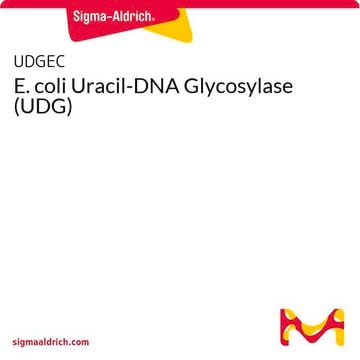11444646001
Roche
Uracil-DNA Glycosylase
recombinant from E. coli K 12
Synonym(e):
PCR, UDG
About This Item
Empfohlene Produkte
Rekombinant
expressed in E. coli
Qualitätsniveau
Form
solution
Verpackung
pkg of 100 U
Hersteller/Markenname
Roche
Konzentration
1000 U/mL
Methode(n)
PCR: suitable
mutagenesis: suitable
Farbe
colorless
pH-Wert
7.9-8.1 (68 °F)
Löslichkeit
water: miscible
Eignung
suitable for molecular biology
Anwendung(en)
life science and biopharma
Fremdaktivität
RNases 10 units, none detected
endonuclease 20 units, none detected
Lagertemp.
−20°C
Verwandte Kategorien
Allgemeine Beschreibung
Spezifität
- Uracil-DNA glycosylase hydrolyzes uracil-glycosidic bonds at U-DNA sites in single- and doublestranded DNA, excising uracil and creating alkali sensitive abasic sites in the DNA.
- The enzyme is more active on single-stranded DNA than on double-standed DNA.
- Activity was also observed on small U-DNA oligonucleotides and on dUMP (Duncan, unpublished observations).
- Uracil-DNA glycosylase is inactive on RNA and native, uracil-free DNA.
Heat inactivation: 95 °C for 10 min
Uracil-DNA glycosylase remains partially active (<10%) after an incubation period of 30 minutes at 95 °C.
Anwendung
- Prevent carryover contamination in PCR
- Increase the efficiency of site-directed mutagenesis procedures
- Label oligonucleotide probes
Qualität
Einheitendefinition
One Lindahl unit is defined as the amount of enzyme necessary to release of 1 μmol uracil at +37 °C in 1 minute. One Lindahl unit is comparable to 520,000 U based on our unit definition.
Volume Activity: 1 U/μl
Physikalische Form
Lagerung und Haltbarkeit
Sonstige Hinweise
Lagerklassenschlüssel
12 - Non Combustible Liquids
WGK
WGK 1
Flammpunkt (°F)
No data available
Flammpunkt (°C)
No data available
Analysenzertifikate (COA)
Suchen Sie nach Analysenzertifikate (COA), indem Sie die Lot-/Chargennummer des Produkts eingeben. Lot- und Chargennummern sind auf dem Produktetikett hinter den Wörtern ‘Lot’ oder ‘Batch’ (Lot oder Charge) zu finden.
Besitzen Sie dieses Produkt bereits?
In der Dokumentenbibliothek finden Sie die Dokumentation zu den Produkten, die Sie kürzlich erworben haben.
Artikel
DNA damage and repair mechanism is vital for maintaining DNA integrity. Damage to cellular DNA is involved in mutagenesis, the development of cancer among others.
Unser Team von Wissenschaftlern verfügt über Erfahrung in allen Forschungsbereichen einschließlich Life Science, Materialwissenschaften, chemischer Synthese, Chromatographie, Analytik und vielen mehr..
Setzen Sie sich mit dem technischen Dienst in Verbindung.






